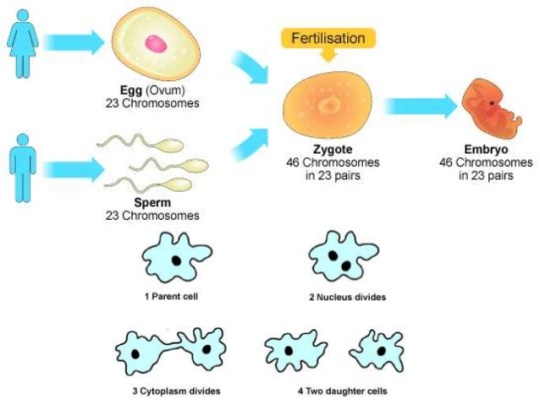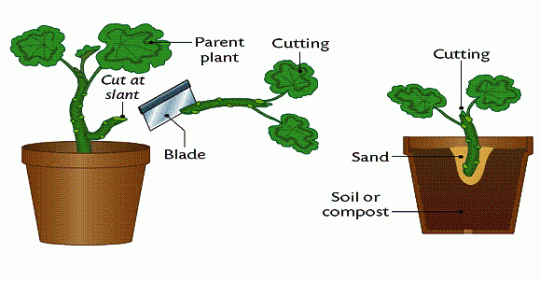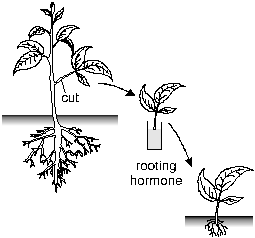Tagged: asexual

Differences between Sexual and Asexual Reproduction: Grade 9 Understanding for IGCSE Biology 3.1 3.2
All organisms have the potential to reproduce. Reproduction is one of the 7 characteristics of life (8 if you study EdExcel IGCSE Biology…..) and of course it means the ability to produce new individuals. But over the 4 billion or so years life has been around on the planet, evolution has developed a myriad ways of producing new individuals. So as biologists are simple folk (well all the ones I work with are….), it makes sense to group different reproductive strategies together to make it easier to understand.
The major distinction between different ways of reproducing is to divide them into asexual and sexual reproduction. This works fairly well, although it seems to be a subject many GCSE students don’t understand too well. So here goes….
The first big idea to dispel is that the number of parents involved determines whether reproduction is sexual or asexual. Too often I am told that asexual involves one parent, sexual two. But although this works in most cases, sexual reproduction can happen with only one parent, for example in flowering plants that self-pollinate. So we need a different way of deciding whether reproduction is sexual or asexual.
And in fact a clear distinction does exist and it is to do with genetics. If the offspring produced are genetically identical to the parent (i.e. a clone) then it is an asexual form of reproduction. If the offspring produced are genetically different to the parents, then it is sexual.
Often sexual reproduction involves the process of fertilisation. This allows two parents to each contribute half their genetic material to their offspring thus generating individuals with new and unique genetic make ups. These specialised cells that contain half the genetic material are called gametes and as you all know, they are made by a special type of cell division called meiosis. Meiosis is vital for sexual reproduction as it produces cells that are haploid (one member of each pair of chromosomes) and all genetically unique.
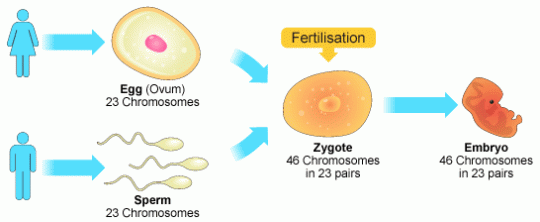
So this diagram shows two humans each producing gametes by meiosis. The parents on the left will have 23 pairs of chromosomes and so each haploid gamete will have 23 individual chromosomes. Fertilisation restores the diploid number. Mitosis is then used to turn this single cell, the zygote into a multicellular embryo and then indeed into a new individual. (You will remember mitosis is a type of cell division that always produces genetically identical daughter cells)
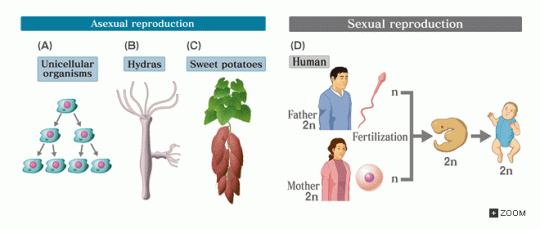
The examples of asexual reproduction on the left all involve only this second type of cell division, mitosis. There are no gametes, no fertilisation and hence no genetic variation. The simplest type of asexual reproduction is shown as (A) and this is called binary fission. A single-celled organism can divide in two to produce two genetically identical daughter cells. Hydra (B) are a simple type of animal and they reproduce by budding. A new individual just grows off the side and when it is big enough, it drops off….. And many plants can reproduce asexually using a technique called vegetative propagation. The sweet potato plant in (C) can produce several offspring plants from each potato but as they are all clones of each other, this is definitely asexual reproduction.
Students do get confused with this topic so please ask me a question using the comment feature below the post. Keep revising hard!
Cell Division part I: Grade 9 Understanding for IGCSE 3.15, 3.28, 3.29
At the beginning of March each year, I get my Y11 classes to draw up a list of topics they want to go through again in revision. Cell Division is always there and it is not difficult to see why. Mitosis doesn’t make any sense unless you understand the concept of homologous pairs of chromosomes and I think you already know that very few iGCSE students do…… (Please see the various posts and videos on the blog on this topic before attempting to understand mitosis)
But there is actually very little to fear in the topic of cell division. If your teacher has told you about the various stages of mitosis that’s fine but you will not be asked to recall them in the exam, at least not if you are studying EdExcel iGCSE. So in this post I am going to try to focus on the key bits of understanding you need rather than bombarding you with unnecessary details.
1 Chromosomes come in pairs
This is the main idea you need before you start. In almost all sexually-reproducing organisms the cells are DIPLOID. This means that however many different sized chromosomes they have, in each cell there will be pairs of chromosomes (called homologous pairs)
So human cells contain 23 pairs of chromosomes (46 in total)
Remember that the number 46 only applies to humans. Other species have very different numbers of chromosomes in each cell (see table below)
So doves have 8 pairs of chromosomes, dogs have 39 pairs of chromosomes, rats 21 pairs of chromosomes. The important point is not how many pairs each organism has but that they all have chromosomes that come in pairs!
The chromosomes any individual possesses is determined at the moment of fertilisation. Sperm and Egg cells (gametes) do not have pairs of chromosomes. They are the only cells in the body that are not diploid. Gametes only have one member of each pair of chromosomes. Cells which only have one member of each pair of chromosomes are called HAPLOID cells.
So every cell in the body is diploid and genetically identical apart from the gametes which are haploid.
2 Organisms that reproduce sexually need two different types of cell division
The fertilised egg (zygote) is a diploid cell. It has pairs of chromosomes that originate one from each parent via the gametes. Every cell division in growth and development of the embryo and foetus until birth, every cell division in growth and repair after birth always produces two genetically identical and diploid cells from the one original cell. This cell division that produces genetically identical diploid cells is called Mitosis.
Gametes (sperm and egg cells) need to be made by a different process. If gametes were diploid then there would be a doubling of the chromosome number every generation and that clearly wouldn’t do. So a different way of dividing the nucleus has evolved. It doesn’t produce genetically identical diploid cells but produces gametes that are haploid and genetically unique. This process is called Meiosis and is only used in the production of gametes.
3 Mitosis is involved in growth, repair, asexual reproduction and cloning
Any process in the body in which the outcome required is the production of genetically identical diploid cells will use mitosis. (It is not too complicated an idea to see that if you don’t need to make gametes and fuse them together in fertilisation, you can just copy cells by mitosis over and over again. All the daughter cells will be exact copies of each other and diploid.
Now I know this post is not going to satisfy everyone. I know some of you will want to read about the cell cycle, prophase, metaphase, centrioles, spindle fibres and the condensation of chromosomes, chromatids being pulled apart etc. etc.) And just for you, I will write a post later today on the details of Mitosis….. But please remember that if you are using the blog to revise for exams, none of this second post is necessary and none of it will be tested in the Edexcel iGCSE paper. If you are doing revision, focus on the key understanding ideas discussed above. And as always, please leave a reply below to ask questions, comment or leave feedback – all comments welcome!

Asexual Reproduction in Plants – Grade 9 Understanding for IGCSE 3.1 3.7
The previous posts have explained the processes involved in sexual reproduction in plants. But many species of plant can also reproduce asexually and this post is going to explain how and why this might occur… Now this is not a topic that is so exciting that it keeps many GCSE students awake at night but there is some good biology in here so pay attention!
Asexual reproduction is the term used for any reproductive strategy that produces genetically identical offspring. The term for a group of genetically identical organisms is a clone and so asexual reproduction is also called cloning. In animals and plants, asexual reproduction only involves one type of cell division, mitosis.
Sexual reproduction on the other hand always introduces genetic variation into the offspring. In the majority of cases, it involves the formation of two haploid gametes (produced in a specialised type of cell division called meiosis) which then fuse together in fertilisation to form a zygote.
This post is not the correct place to discuss the advantages and disadvantages of the two types of reproduction. But sexual reproduction comes at a cost for an organism: in plants this cost is the energy spent making attractive petals and scent to attract insect pollinators, the cost of wasting millions of pollen grains just to ensure some are transferred, the cost of making sweet tasty fruits for animals to eat. I am writing this the day after Valentine’s Day in the UK which illustrates the courtship costs for animals quite well…..
Asexual Reproduction in Plants:
Plants have evolved a variety of asexual strategies shown in the picture above. We only really need to consider one for your iGCSE exam and that is runners. Some plants, the classic example is the strawberry grow long horizontal stems outwards from the parent plant. When this “runner” touches the ground, root development is switched on and a new plant starts to grow upwards. When the runner dies back, you are left with two genetically identical plants, hence Asexual Reproduction.
(This diagram is a little misleading…. The runner is not the name of the offspring plant, it is the long horizontal structure growing outwards just above the soil from the parent plant)
If you are really interested in learning more about asexual strategies in plants, well you should probably get out more… But you could study how tubers (such as in potato) and bulbs (such as the onion) allow plants both to over-winter and also produce clones.
Artificial Methods of Asexual Reproduction in Plants
This is quite weird if you think about it….. A human can cause asexual reproduction in many species of plant by “taking a cutting“. As the name suggests this involves cutting off a small part of the plant (including a leaf and part of the stalk) and then sticking it into soil to grow a new plant. The only type of cell division in this process is mitosis and so the plant produced from the cutting will be a clone of its parent (genetically identical).
This is an example of artificial asexual reproduction in plants. It is a useful strategy for gardeners as it allows you to produce lots of new plants for your garden without shelling out hard-earned cash at the garden centre….
Cuttings work much better if in between taking the cutting and planting it in a small pot of compost, the cut end of the stalk is dipped in a mixture of chemicals calling a “rooting powder”
Rooting powder contains a mixture of plant growth substances (sometimes incorrectly called hormones) that can switch on the genetic programme of root production.
I hope you find this post useful. It probably holds the record for the dullest site anywhere on the World Wide Web…. Typing this has made me feel sleepy, so I am going to lie down…..
Please add comments/questions or tweet me if anything is unclear.



